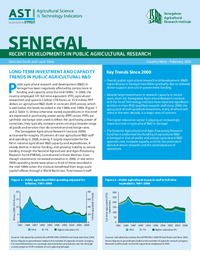Authors:
Stads, Gert-Jan; Sawadogo Kaboré, Séraphine
Year:
2010
Publisher
International Food Policy Research Institute (IFPRI); and Environment and Agricultural Research Institute (INERA)
Back to:
In 2008, Burkina Faso’s investments in agricultural R&D totaled 3.9 billion CFA francs, or 19.5 million dollars (both in 2005 prices). This amount included the salary, operational, and program costs that were covered through government contributions, and donor grants and loans, as well as capital investments. Agricultural R&D funding was seen to follow a very unstable pattern over the past few decades. Between 1989 and 2004, the World Bank played a role in the field of agricultural R&D by conducting two major projects.
Following the closure of these projects, INERA and IRSAT found themselves facing a financial crisis that seriously disrupted their daily performance and that prevented the recruitment of new researchers. INERA’s rapidly aging research staff poses a real threat to Burkina Faso’s agricultural research development.
Indeed, even if on the whole the country’s agricultural researchers rank among the most highly qualified scientists in West Africa, the importance of recruiting and training young researchers remains crucial to securing a critical mass for the long term.
While capacity strengthening is a component of WAAPP, the question still remains as to how many new researchers will actually be recruited. The launching of the national WAAPP component will doubtlessly herald a temporary improvement of Burkina Faso’s financial situation, but in the long run, the government will have to take the necessary steps to consolidate the program gains. It will have to take charge of financing agricultural research in order to avoid continued investments fluctuations, that is, to end the instability which has characterized Burkina Faso’s agricultural research to date.

